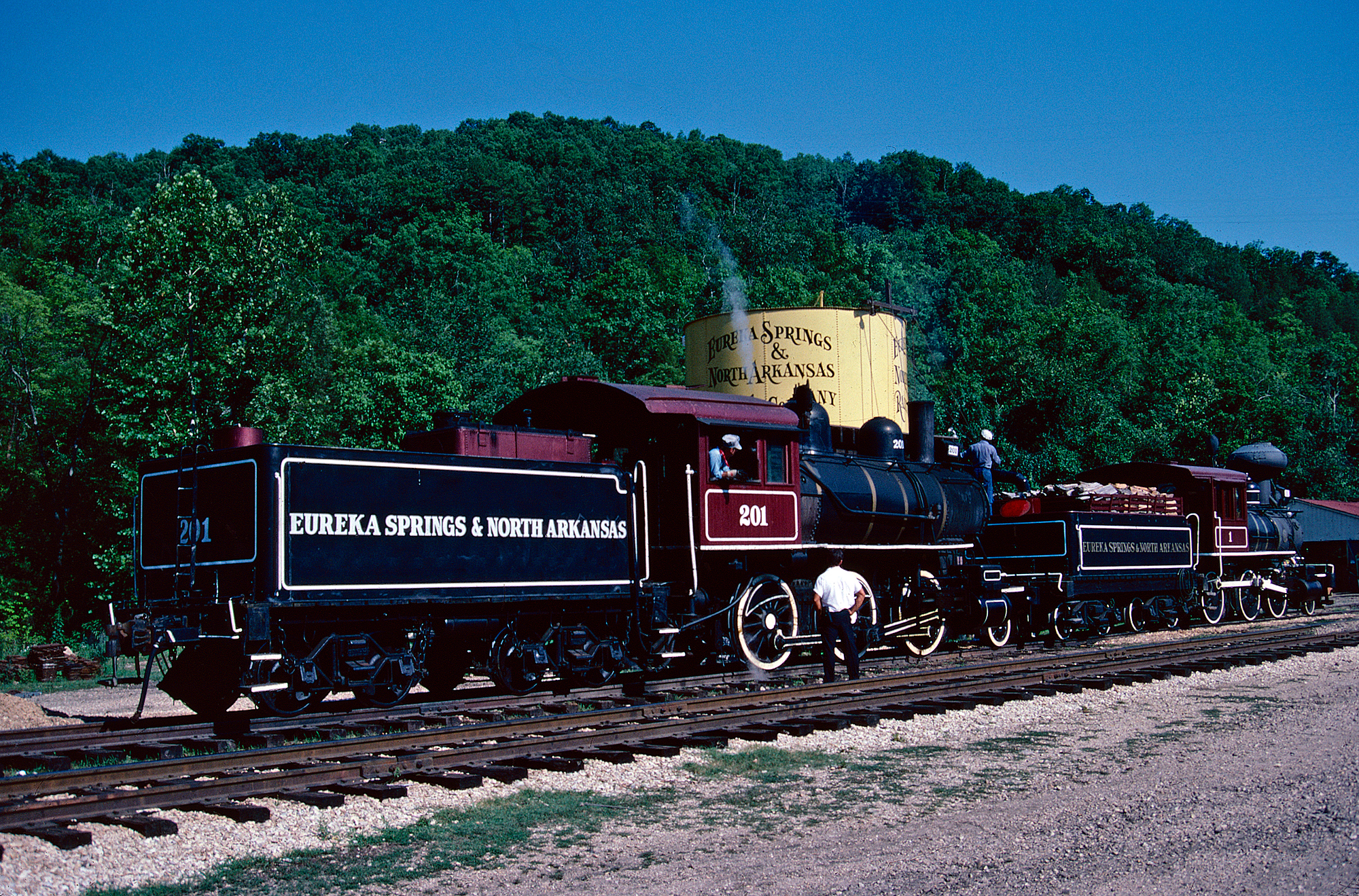The "City of Denver": The M-10005 Trainset
Last revised: August 25, 2024
By: Adam Burns
The City of Denver was just one train in the Union Pacific’s premier fleet of passenger trains. As one of the first streamliners released the Denver
was incredibly popular with the traveling public.
The UP would go on to host an entire array of other plush City trains including the City of Portland, City of Los Angeles, City of Salina, City of St. Louis, City of San Francisco, and City of Las Vegas.
Originally a joint operation with the Chicago & North Western, the Denver was quite successful and its name remained on UP's timetable until the startup of Amtrak.
Today, the City fleet can still be witnessed, in a manner of speaking, as the UP’s official business train is not only decorated in the Cities’ classic livery but also includes the original equipment from them, right down to the two E9As and E9Bs that power it!
Photos
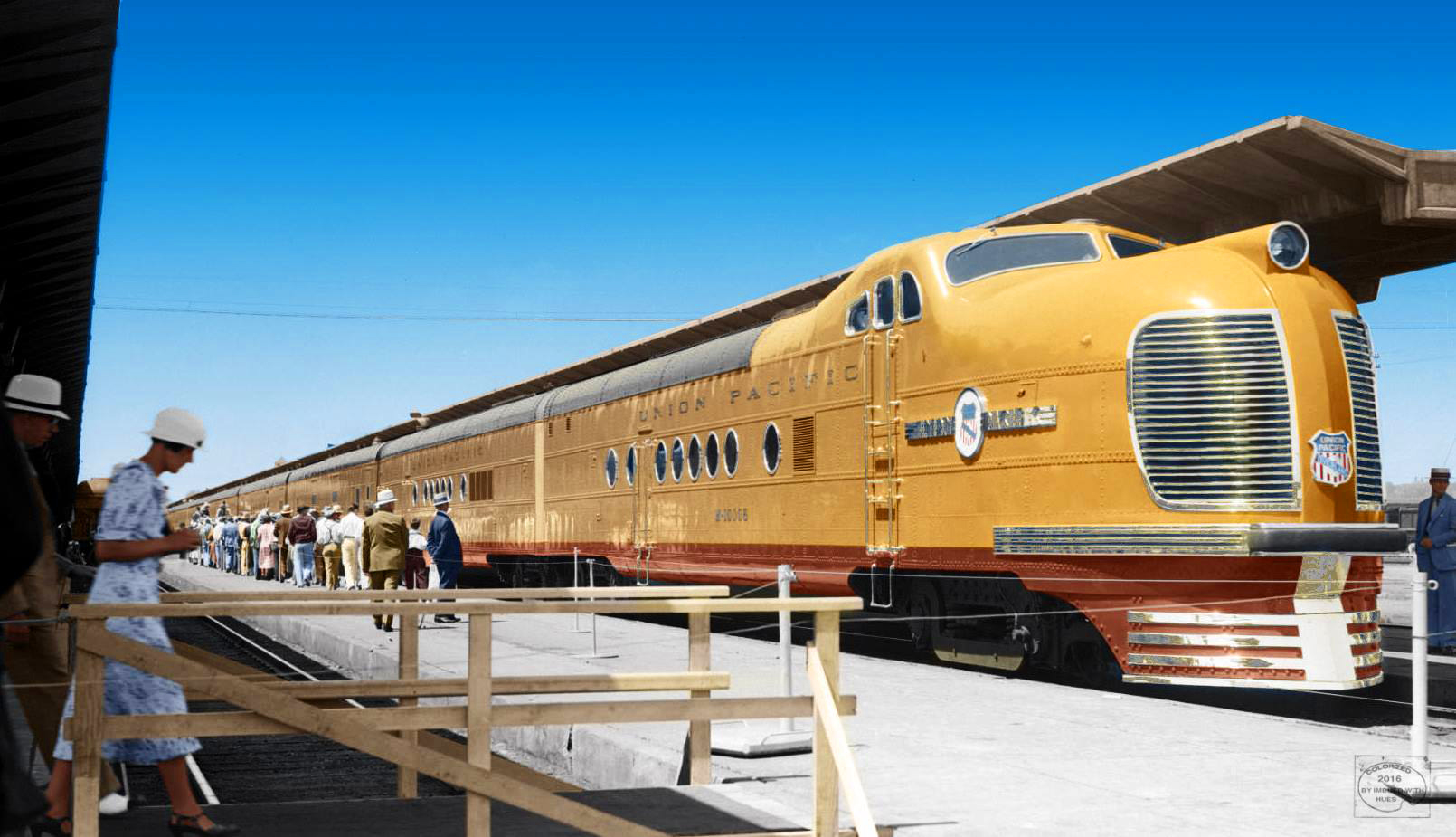 Union Pacific's M-10005, the "City Of Denver," sits on display at Denver Union Station on June 14, 1936 a few days before the new streamliner officially entered service (June 18th). Otto Perry photo/colorized by Patty Allison.
Union Pacific's M-10005, the "City Of Denver," sits on display at Denver Union Station on June 14, 1936 a few days before the new streamliner officially entered service (June 18th). Otto Perry photo/colorized by Patty Allison.History
Union Pacific, the largest and one of the most powerful railroads in the country, has been with us since 1862. The company is far older than any other American Class I railroad today with the Kansas City Southern in a nearby second.
In that time UP has become not only one of the most highly respected institutions in the nation but also has seen nearly every major railroading event in our country’s history, and accordingly has a very long and storied history.
M-10005
The original City of Denver took to the rails on June 18, 1936 as the railroad's M-10005 and M-10006 semi-articulated trainsets from the Electro-Motive Corporation (of which the railroad owned a total of seven).
These trainsets featured three baggage cars on the head-end (two were combination RPOs/bars), a diner, three sleepers, and a sleeper-lounge observation.
At A Glance
17 Hours (Westbound) 16 Hours, 15 Minutes (Eastbound) |
|
111 (Westbound) 112 (Eastbound) | |
Union Pacific (Denver - Omaha, Nebraska) Chicago & North Western (Omaha - Chicago): Until October, 1955 Milwaukee Road (Omaha - Chicago): After October, 1955 | |
Union Station (Denver) North Western Station (Chicago)/Union Station (Chicago) |
The train was bedecked in western themes (for instance, its cars were adorned in a rustic, frontier/western style using lots of wood and even rifles and animal heads for interior decorations).
It was one of the first streamliners in service between Denver and Chicago offered a blazing fast schedule dazzling the public, and ridership quickly exploded.
Consist (1952)
Of course, the train had stiff competition in this market, the Chicago, Burlington & Quincy and its Denver Zephyr, which was inaugurated soon after the City of Denver.
The two trains competed vigorously for decades and because of their fast schedules, high quality of service, and accommodations both were quite successful. For the Denver's part it could make the run between Chicago and Denver in about 16 hours, carrying an average train speed of nearly 67 mph.
Modern Equipment
In the 1950s the Denver was completely reequipped with equipment built by Pullman-Standard, American Car & Foundry, and power provided by EMD (originally E7s, and later E8s and E9s).
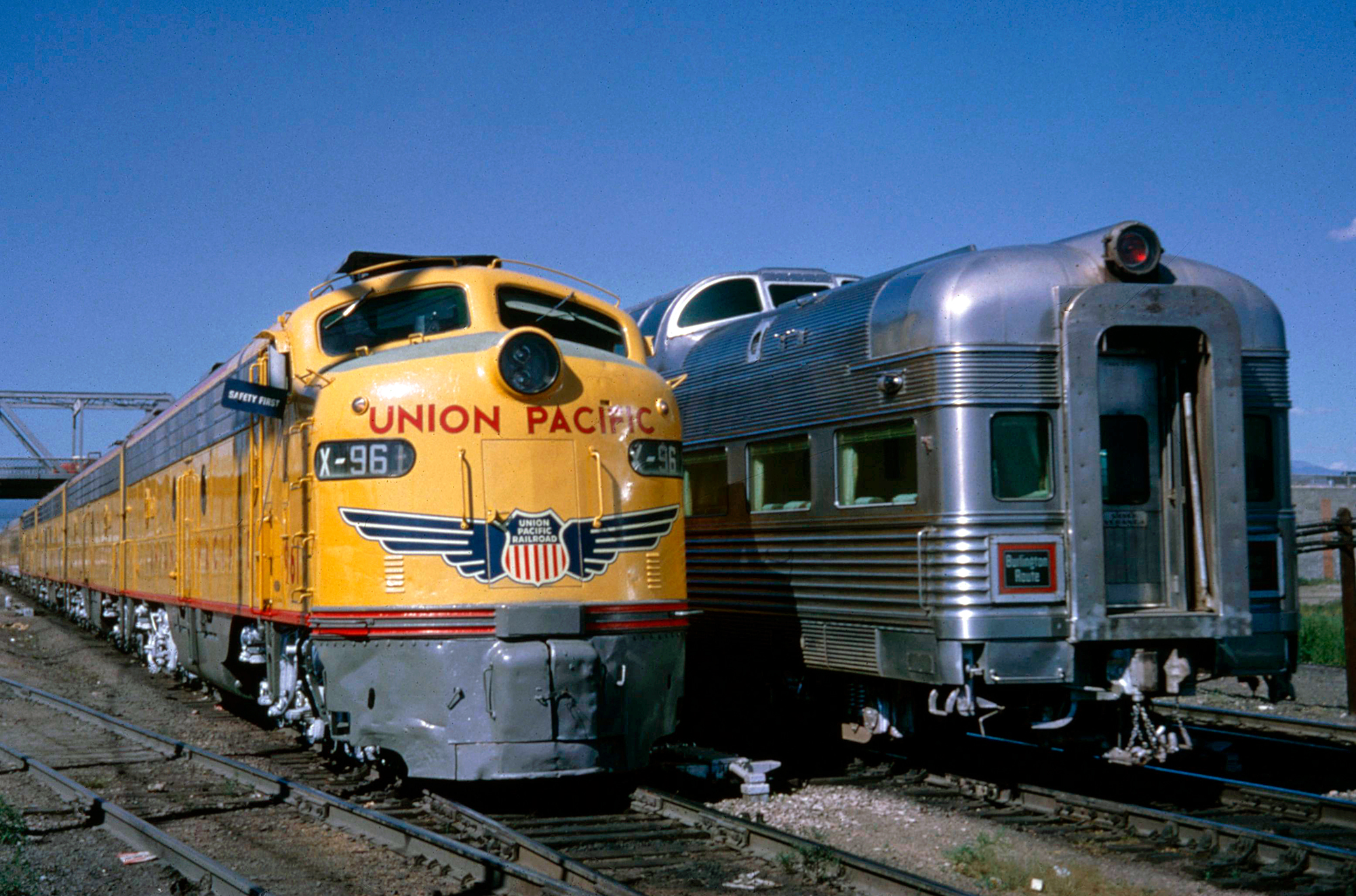 Union Pacific E9A #961 awaits departure from Denver Union Station with train #112, the eastbound "City of Denver," on the afternoon of July 2, 1963. Burlington's "Denver Zephyr" can be seen in the next track over. American-Rails.com collection.
Union Pacific E9A #961 awaits departure from Denver Union Station with train #112, the eastbound "City of Denver," on the afternoon of July 2, 1963. Burlington's "Denver Zephyr" can be seen in the next track over. American-Rails.com collection.This new equipment included diners, lounges, coaches,
sleepers, and observations.
Like several of the UP’s City trains, for nearly 20 years the train was operated in conjunction with the Chicago & North
Western, which ferried it from Omaha to Chicago.
This setup lasted until 1955 when the UP, dissatisfied with the services C&NW was providing, handed the train over to the Milwaukee Road, a partnership that would last until the train’s end.
It was also during this time the train finally received domes when Milwaukee Road's "Super Domes" making appearances as early as 1957. It was during this time UP began marketing the train as a "Domeliner." According to Mike Schafer and Joe Welsh's book, "Streamliners: History Of A Railroad Icon," in 1959 the City of Denver received its first Astra-Domes when it was combined with the City of Portland between Chicago and Denver.
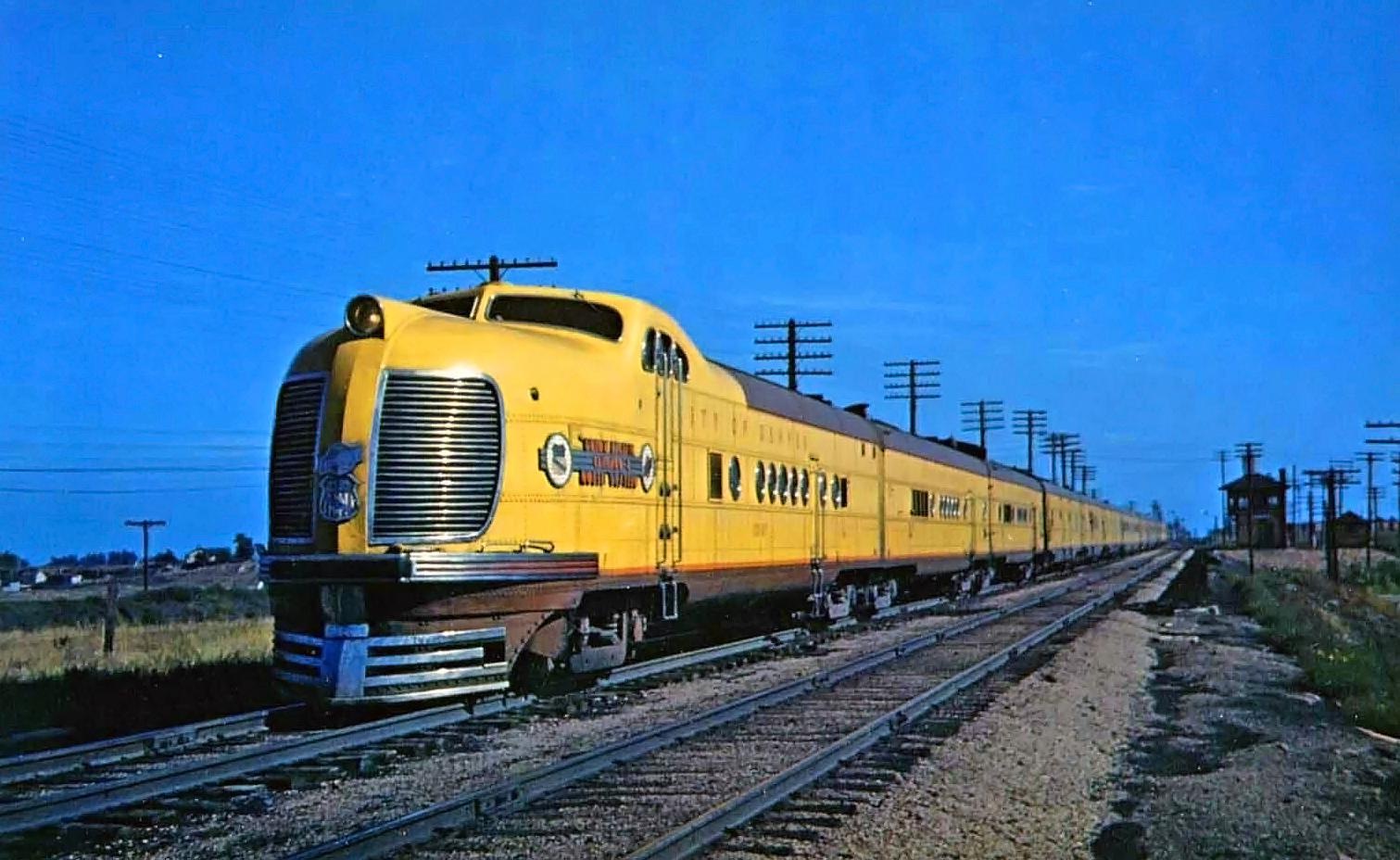 Union Pacific's M-10005 trainset, the "City of Denver," has just crossed the Chicago, Burlington & Quincy/Colorado & Southern north of Denver, Colorado on September 14, 1940. Richard Kindig photo.
Union Pacific's M-10005 trainset, the "City of Denver," has just crossed the Chicago, Burlington & Quincy/Colorado & Southern north of Denver, Colorado on September 14, 1940. Richard Kindig photo.The latter had been rerouted that year via Denver instead of Cheyenne. Interestingly, Burlington had nearly always operated domes on its Denver Zephyr, one of its marketing attributes.
However, Union Pacific initially declined to purchase such cars for its Denver service, arguing the lack of scenery and the train's overnight schedule. While the City of Denver competed directly with the Burlington’s Denver Zephyr to a lesser degree it also competed with the Rock Island’s Rocky Mountain Rocket.
Timetable (November, 1940)
| Read Down Time/Leave (Train #111/Chicago & North Western) | Milepost | Location | Read Up Time/Arrive (Train #112/Chicago & North Western) |
|---|---|---|---|
| 6:20 PM (Dp) | 0.0 | 8:33 AM (Ar) | |
| 8 | F | ||
| 8:04 PM | 109 | 6:36 AM | |
| 8:32 PM | 138 | 6:10 AM | |
| 9:46 PM | 219 | 4:53 AM | |
| 10:50 PM | 289 | 3:46 AM | |
| 11:22 PM | 326 | 3:13 AM | |
| 11:40 PM | 340 | 3:00 AM | |
| 1:46 AM | 485 | 12:55 AM | |
| 1:49 AM | 486 | ||
| 2:01 AM (Ar) | 487 | 12:45 AM (Dp) | |
| Time/Leave (Train #111/Union Pacific) | Milepost | Location | Time/Arrive (Train #112/Union Pacific) |
| 2:10 AM (Dp) | 487 | 12:35 AM (Ar) | |
| F | 570 | 11:16 PM | |
| 4:10 AM | 632 | 10:30 AM | |
| 4:46 AM | 674 | 9:56 AM | |
| 6:02 AM (Ar) | 769 | 8:45 PM (Dp) | |
| 5:08 AM (Dp) | 769 | 7:43 PM (Ar) | |
| 6:17 AM | 851 | 6:40 AM | |
| 7:12 AM | 908 | 5:54 AM | |
| 7:47 AM | 949 | ||
| 8:31 AM | 1001 | 4:37 AM | |
| 9:20 AM (Ar) | 1048 | 3:55 AM (Dp) |
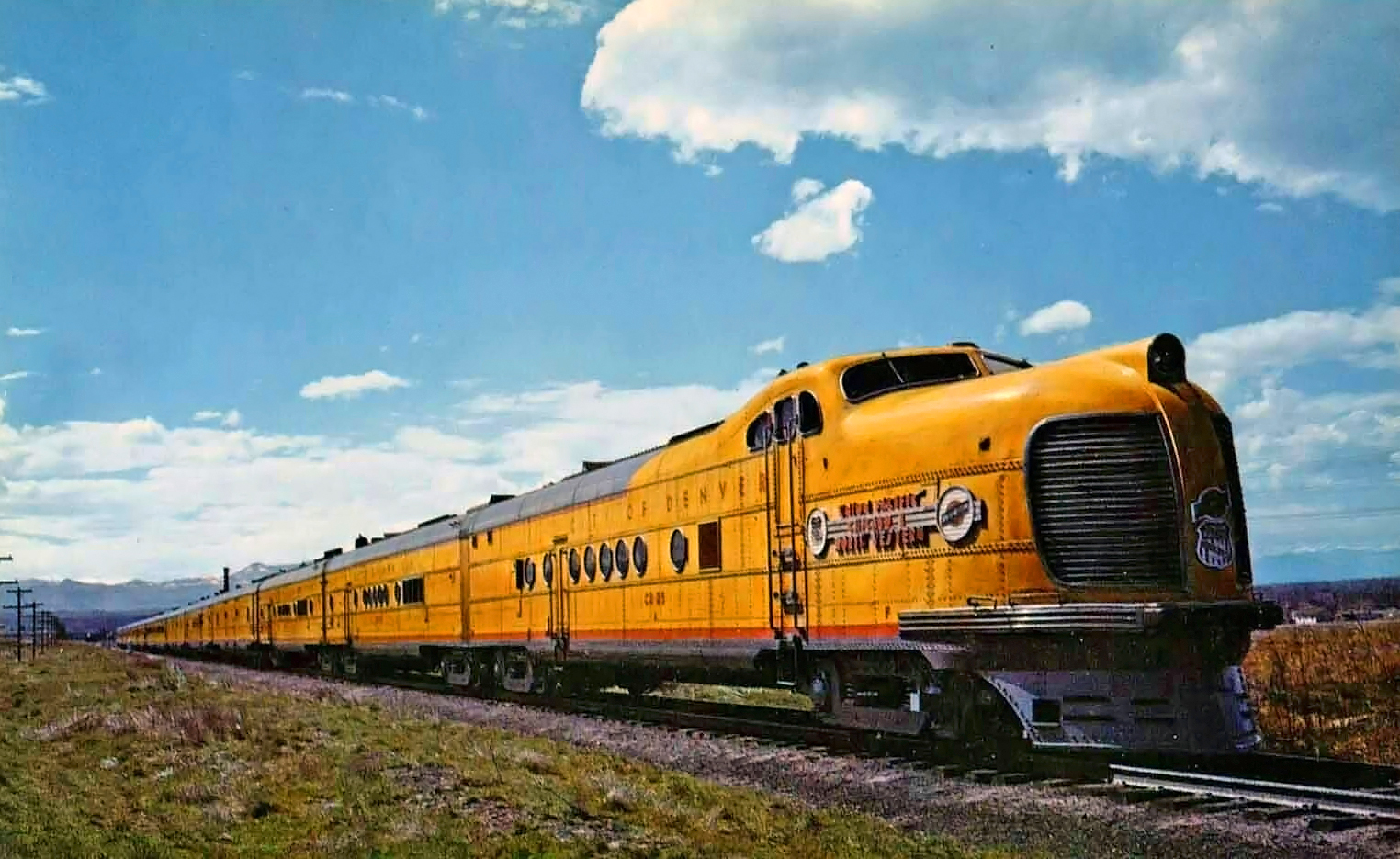 This well-known Union Pacific publicity photo features the early "City of Denver" trainset in Denver, Colorado in 1940.
This well-known Union Pacific publicity photo features the early "City of Denver" trainset in Denver, Colorado in 1940.Final Years
While the Rock Island's train was never quite as popular as its two competitors', in part due to its late entry, the Rocky Mountain Rocket still found success due to the large population centers it served.
Following the City of Portland's 1959 rerouting via Denver, the City of Denver's era as a separate service had more or less came to an end although the train's name remained on the timetable. As ridership continued to decline, industry-wide, further cutbacks occurred nearly ten years later when the City of Portland returned to its former routing in 1968.
Subsequent with this move, the City of Denver became merely a connecting service of the Portland at North Platte, Nebraska. At this time the train was equipped with only a reclining seat coach and Pullman sleeper. The City of Portland, and the entirety of Union Pacific's City fleet, was combined into one giant City of Los Angeles/Challenger east of Green River, Wyoming in late 1969.
The trains were split at this point to finish their journeys as as separate services to reach their final destinations. This setup continued for more than a year until Amtrak took over most intercity passenger services on May 1, 1971.
Contents
Recent Articles
-
Arizona Railroad Museums: A Complete Guide
Apr 16, 25 01:17 PM
Learn about Arizona's rich history with railroads at one of several museums scattered throughout the state. More information about these organizations may be found here. -
Arkansas Railroad Museums: A Complete Guide
Apr 16, 25 12:59 PM
The state of Arkansas is home to a handful of small railroad museums. Learn more about these organizations here. -
Alabama Railroad Museums: A Complete Guide
Apr 16, 25 12:30 PM
Alabama, with its storied past and vibrant connection to the railroad industry, is home to several captivating railroad museums.



